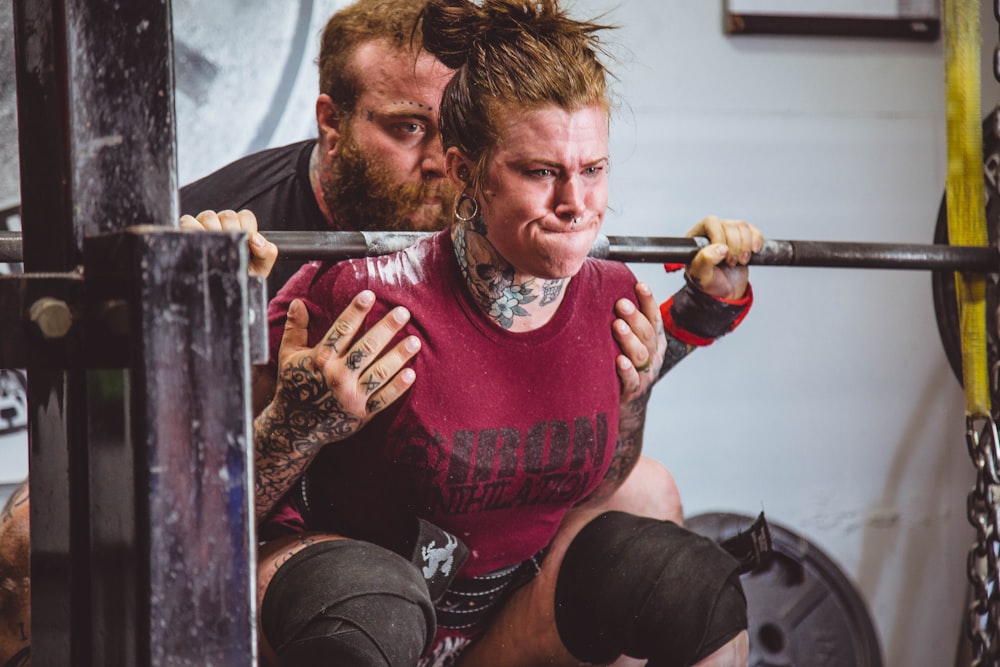目次
変形性膝関節症例に高強度の筋力トレーニングは無益
理学療法士・作業療法士が変形性膝関節症例に筋力トレーニングを行うことは多いと思います.
ただ筋力トレーニングって本当に意味があるのか疑問に思うこともしばしばだと思います.
昔から変形性膝関節症といえば大腿四頭筋トレーニングと考えられてきましたが,変形性膝関節症の原因って内反モーメントの増大が問題であって,大腿四頭筋の筋力低下が変形性膝関節症を引き起こすわけではありませんよね?
もちろん変形性膝関節症の結果,大腿四頭筋の筋力低下も合併するわけですが,そもそも変形性膝関節症例に対する大腿四頭筋トレーングって原因を解決する手段ではないことが多いと思います.
今回は米ノースカロライナ州在住の変形性膝関節症例を対象に行われた高強度筋力トレーニングの効果を明らかにした最新の研究論文をご紹介させていただきます.

今回ご紹介する論文
JAMA. 2021 Feb 16;325(7):646-657. doi: 10.1001/jama.2021.0411.
Effect of High-Intensity Strength Training on Knee Pain and Knee Joint Compressive Forces Among Adults With Knee Osteoarthritis: The START Randomized Clinical Trial
Stephen P Messier 1 2, Shannon L Mihalko 3, Daniel P Beavers 4, Barbara J Nicklas 2 3, Paul DeVita 5, J Jeffery Carr 6, David J Hunter 7, Mary Lyles 2, Ali Guermazi 8, Kim L Bennell 9, Richard F Loeser 10
Affiliations expand
PMID: 33591346 DOI: 10.1001/jama.2021.0411
今回ご紹介する論文は2021年に掲載された論文です.
JAMAに掲載され,話題になった論文ですね.
研究の重要性
Importance: Thigh muscle weakness is associated with knee discomfort and osteoarthritis disease progression. Little is known about the efficacy of high-intensity strength training in patients with knee osteoarthritis or whether it may worsen knee symptoms.
大腿四頭筋の筋力低下は膝の不快感や変形性膝関節症の進行と関連しています.
しかしながら変形性膝関節症例における高強度筋力トレーニングの有効性や,膝の症状を悪化させる可能性があるかどうかについては明らかではありません.
研究の目的
Objective: To determine whether high-intensity strength training reduces knee pain and knee joint compressive forces more than low-intensity strength training and more than attention control in patients with knee osteoarthritis.
この研究では,変形性膝関節症例を対象として高強度筋力トレーニングが低強度筋力トレーニングや対照群よりも膝関節痛と膝関節圧縮力を軽減するか否かを明らかにすることを目的としております.
研究デザイン・セッティング・対象
Design, setting, and participants: Assessor-blinded randomized clinical trial conducted at a university research center in North Carolina that included 377 community-dwelling adults (≥50 years) with body mass index (BMI) ranging from 20 to 45 and with knee pain and radiographic knee osteoarthritis. Enrollment occurred between July 2012 and February 2016, and follow-up was completed September 2017.
この研究はノースカロライナ州の大学の研究センターで実施された評価者盲検化無作為化臨床試験です.
BMが20~45で膝痛とX線画像上の変形性膝関節症を有する地域在住成人377例(50歳以上)を対象としております.
登録は2012年7月から2016年2月に行われ,追跡調査は2017年9月に完了しております.
介入
Interventions: Participants were randomized to high-intensity strength training (n = 127), low-intensity strength training (n = 126), or attention control (n = 124).
対象者は高強度筋力トレーニング群(n=127),低強度筋力トレーニング群(n=126),または対照群(n=124)の3群に無作為に割り付けられております.
主要アウトカム測定
Main outcomes and measures: Primary outcomes at the 18-month follow-up were Western Ontario McMaster Universities Osteoarthritis Index (WOMAC) knee pain (0 best-20 worst; minimally clinically important difference [MCID, 2]) and knee joint compressive force, defined as the maximal tibiofemoral contact force exerted along the long axis of the tibia during walking (MCID, unknown).
主要評価項目は介入から18カ月時のWestern Ontario McMaster Universities Osteoarthritis Index(WOMAC)疼痛スコア[0-20点,最小重要差(MCID)2点]と膝関節への圧迫力(歩行中の脛骨長軸に沿った脛骨大腿骨接触部の最大圧迫力と定義,MCID不明)としております.
研究の結果
Results: Among 377 randomized participants (mean age, 65 years; 151 women [40%]), 320 (85%) completed the trial. Mean adjusted (sex, baseline BMI, baseline outcome values) WOMAC pain scores at the 18-month follow-up were not statistically significantly different between the high-intensity group and the control group (5.1 vs 4.9; adjusted difference, 0.2; 95% CI, -0.6 to 1.1; P = .61) or between the high-intensity and low-intensity groups (5.1 vs 4.4; adjusted difference, 0.7; 95% CI, -0.1 to 1.6; P = .08). Mean knee joint compressive forces were not statistically significantly different between the high-intensity group and the control group (2453 N vs 2512 N; adjusted difference, -58; 95% CI, -282 to 165 N; P = .61), or between the high-intensity and low-intensity groups (2453 N vs 2475 N; adjusted difference, -21; 95% CI, -235 to 193 N; P = .85). There were 87 nonserious adverse events (high-intensity, 53; low-intensity, 30; control, 4) and 13 serious adverse events unrelated to the study (high-intensity, 5; low-intensity, 3; control, 5).
無作為化された377人の対象者(平均年齢65歳;女性151人[40%])のうち,320例(85%)が試験を完了しております.
18カ月追跡調査時,補正後の平均WOMAC疼痛スコアは,高強度群および対照群間(5.1点 vs 4.9点,補正後の差0.2点,95%CI -0.6-1.1,P=0.61),高強度群および低強度群間(5.1点 vs 4.4点,同0.7点,-0.1-1.6,P=0.08)ともに有意差が認められませんでした.
膝関節への平均圧迫力についても,高強度群と対照群間,高強度群と低強度群間で有意差が認められませんでした.
非重篤な有害事象が87件(高強度群53件,低強度群30件,対照群4件),試験に無関連の重篤な有害事象が13件(それぞれ5件,3件,5件)発生しております.
研究の結論
Conclusions and relevance: Among patients with knee osteoarthritis, high-intensity strength training compared with low-intensity strength training or an attention control did not significantly reduce knee pain or knee joint compressive forces at 18 months. The findings do not support the use of high-intensity strength training over low-intensity strength training or an attention control in adults with knee osteoarthritis.
変形性膝関節症例において,低強度筋力トレーニング群または対照群に比較して高強度筋力トレーニングを行っても,18 ヵ月後の膝痛または膝関節圧迫力に有意差は見られませんでした.
この結果から,成人の変形性膝関節症例において,低強度筋力トレーニングや対照群よりも高強度筋力トレーニングが有用であると結論付けられないことが示唆されます.
今回は米ノースカロライナ州在住の変形性膝関節症例を対象に行われた高強度筋力トレーニングの効果を明らかにした最新の研究論文をご紹介させていただきました.
今回の研究結果から考えると変形性膝関節症例を対象に行われる筋力トレーニングの強度は高強度である必要はないと考えられます.
今回の結果を見ても有害事象の件数も明らかに高強度筋力トレーニング群で多い傾向にあります.
最近は高齢者に対する筋力トレーニングも低負荷・高頻度が1つのキーワードになっておりますので,変形性膝関節症例においてもリスクを考えると低負荷・高頻度がポイントになりそうですね.






